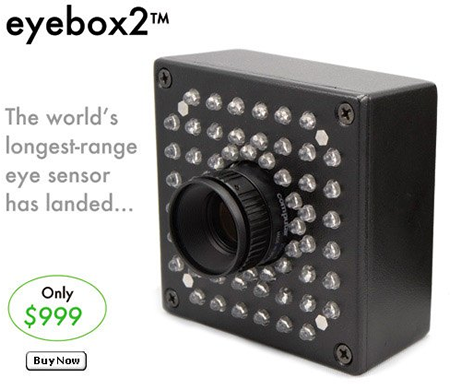Interactions in the offline world have metrics, too, and thanks to a Canadian startup advertisers will have a way to measure them. The eyebox, unveiled at Google on May 7, can track views of a plasma screen to give malls and stores the same advertising revenue model websites use when selling page views.
The eyebox2 has a range up to 10 meters, allowing positioning with mall billboards to count how many people actually look at the ads. The camera costs about one grand and plugs into a USB port to interact with tracking software. The device has other potential uses, too, including voting for posters and controlling video games with your eyes.
Founded in 2005 and based in Ontario, xuuk is a startup designer and manufacturer of gaze sensing technology. They work with third-party developers who want to integrate computer vision data into applications. The company is affiliated with the media lab at Queen’s University, which has some interesting projects which also involve paper displays, eyeblogging, and focus in video conferencing. Roel Vertegaal, the CEO of xuuk and an associate professor at Queens, holds degrees is Electronic Music (Utrecht Conservatory, Netherlands), Computing (Britain), HCI (Twente University), and also studied design in The Hague.
Contemporary eye tracking gear costs upwards of $25,000, has limited range and requires precise calibration. Vertegaal’s device leverages the “red eye effect” by intentionally inducing reflected light from a person’s retina to detect whether someone is looking directly at the camera. The use of this suddenly affordable technology with billboard advertising will be more accurate and ultimately less costly than the traditional eyeball counting done by a human with a pen and notebook.
Vertegaal’s vision for eyebox goes beyond advertising, however. xuuk wants to make everyday devices more aware of how interested the people using them are from one moment to the next. Vertegaal sees his invention as a way to bring mouse-like control to the physical world by allowing eye gaze to determine what gets focus. Televisions that aren’t being watched can mute or power down. Hearing aids can amplify the speech of a specific person while that person is being observed. For now, the advertising industry is the easiest to convince.
